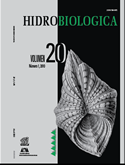Sources analysis and equivalent toxicity assessment of PAHs impacted sediments in Bahia Blanca Estuary, Argentina
Keywords:
Sediments, Bahía Blanca estuary, molecular ratios, guidelines, carcinogenic PAHsAbstract
This paper presents a comprehensive survey of PAHs in coastal sediments of Bahia Blanca, Argentina and provides useful information of their levels of concentration, sources, ecotoxicological assessment and carcinogenic PAHs profile of local emissions. Sediments were analyzed following Environmental Protection Agency (EPA, USA) protocols by means of Gas Chromatography-Mass Spectrometry, showing total concentrations of PAHs in a range from 103 to more than 2,000 ng.g-1 (mean: 527 ± 114 ng.g-1; median: 507 ng.g-1). A dynamic state of PAHs pollution was demonstrated for the area which was defined by widespread low to moderate levels, but including punctual zones with high pollution processes. Molecular ratios calculations determined a generalized overimposition of pyrolitic PAHs over the petrogenic input. The pyrolitic pattern moved to a biomass burning origin during summer, the period of highest recorded fires. In addition, the ecotoxicological guidelines approach for PAHs chemical concentrations in sediment defined a rare occurrence of biological effects for the majority of sampled sites; however, frequent effects were expected for punctual locations. Further, Total Benzo-a-pyrene equivalents from several sampling stations were found to be above international regulations. Finally, the PAHs carcinogenic dose was calculated using the BaP equivalent factors approach and compared with other worldwide coastal studies by means of Hierarchical Cluster Analysis.Downloads
Downloads
Published
How to Cite
Issue
Section
License
Los autores/as que publiquen en esta revista aceptan las siguientes condiciones:
De acuerdo con la legislación de derechos de autor, HIDROBIOLÓGICA reconoce y respeta el derecho moral de los autores, así como la titularidad del derecho patrimonial, el cual será cedido a la revista para su difusión en acceso abierto.
Publicar en la revista HIDROBIOLÓGICA tiene un costo de recuperación de $500 pesos mexicanos por página en blanco y negro (aproximadamente 29 dólares americanos) y $1000 pesos por página a color (aproximadamente 58 dólares americanos).
Todos los textos publicados por HIDROBIOLÓGICA sin excepción se distribuyen amparados bajo la licencia Creative Commons 4.0Atribución-No Comercial (CC BY-NC 4.0 Internacional), que permite a terceros utilizar lo publicado siempre que mencionen la autoría del trabajo y a la primera publicación en esta revista.
Los autores/as pueden realizar otros acuerdos contractuales independientes y adicionales para la distribución no exclusiva de la versión del artículo publicado en HIDROBIOLÓGICA (por ejemplo incluirlo en un repositorio institucional o publicarlo en un libro) siempre que indiquen claramente que el trabajo se publicó por primera vez en HIDROBIOLÓGICA.
Para todo lo anterior, el o los autor(es) deben remitir el formato de Carta-Cesión de la Propiedad de los Derechos de la primera publicación debidamente requisitado y firmado por el autor(es). Este formato se puede enviar por correo electrónico en archivo pdf al correo: enlacerebvistahidrobiológica@gmail.com; rehb@xanum.uam.mx (Carta-Cesión de Propiedad de Derechos de Autor).
Esta obra está bajo una licencia de Creative Commons Reconocimiento-No Comercial 4.0 Internacional.


